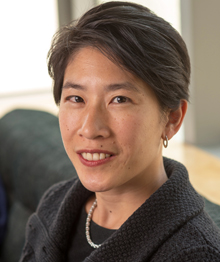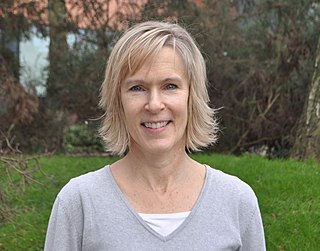
Jacqueline K. Barton, is an American chemist. She worked as a Professor of Chemistry at Hunter College (1980–82), and at Columbia University (1983–89) before joining the California Institute of Technology. In 1997 she became the Arthur and Marian Hanisch Memorial Professor of Chemistry and from 2009 to 2019, the Norman Davidson Leadership Chair of the Division of Chemistry and Chemical Engineering at Caltech. She currently is the John G. Kirkwood and Arthur A. Noyes Professor of Chemistry.

Armand Paul Alivisatos is an American chemist and academic administrator who has served as the 14th president of the University of Chicago since September 2021. He is a pioneer in nanomaterials development and an authority on the fabrication of nanocrystals and their use in biomedical and renewable energy applications. He was ranked fifth among the world's top 100 chemists for the period 2000–2010 in the list released by Thomson Reuters.

George McClelland Whitesides is an American chemist and professor of chemistry at Harvard University. He is best known for his work in the areas of nuclear magnetic resonance spectroscopy, organometallic chemistry, molecular self-assembly, soft lithography, microfabrication, microfluidics, and nanotechnology. A prolific author and patent holder who has received many awards, he received the highest Hirsch index rating of all living chemists in 2011.

Carolyn Ruth Bertozzi is an American chemist and Nobel laureate, known for her wide-ranging work spanning both chemistry and biology. She coined the term "bioorthogonal chemistry" for chemical reactions compatible with living systems. Her recent efforts include synthesis of chemical tools to study cell surface sugars called glycans and how they affect diseases such as cancer, inflammation, and viral infections like COVID-19. At Stanford University, she holds the Anne T. and Robert M. Bass Professorship in the School of Humanities and Sciences. Bertozzi is also an Investigator at the Howard Hughes Medical Institute (HHMI) and is the former Director of the Molecular Foundry, a nanoscience research center at Lawrence Berkeley National Laboratory.

Ronald T. Raines is an American chemical biologist. He is the Roger and Georges Firmenich Professor of Natural Products Chemistry at the Massachusetts Institute of Technology. He is known for using ideas and methods of physical organic chemistry to solve important problems in biology.

JoAnne Stubbe is an American chemist best known for her work on ribonucleotide reductases, for which she was awarded the National Medal of Science in 2009. In 2017, she retired as a Professor of Chemistry and Biology at the Massachusetts Institute of Technology.
Kristi S. Anseth is the Tisone Distinguished Professor of Chemical and Biological Engineering, an Associate Professor of Surgery, and a Howard Hughes Medical Investigator at the University of Colorado at Boulder. Her main research interests are the design of synthetic biomaterials using hydrogels, tissue engineering, and regenerative medicine.
Laura Lee Kiessling is an American chemist and the Novartis Professor of Chemistry at the Massachusetts Institute of Technology. Kiessling's research focuses on elucidating and exploiting interactions on the cell surface, especially those mediated by proteins binding to carbohydrates. Multivalent protein-carbohydrate interactions play roles in cell-cell recognition and signal transduction. Understanding and manipulating these interactions provides tools to study biological processes and design therapeutic treatments. Kiessling's interdisciplinary research combines organic synthesis, polymer chemistry, structural biology, and molecular and cell biology.

Donald E. Ingber is an American cell biologist and bioengineer. He is the founding director of the Wyss Institute for Biologically Inspired Engineering at Harvard University, the Judah Folkman Professor of Vascular Biology at Harvard Medical School and Boston Children's Hospital, and Professor of Bioengineering at the Harvard John A. Paulson School of Engineering and Applied Sciences. He is also a member of the American Institute for Medical and Biological Engineering, the National Academy of Engineering, the National Academy of Medicine, the National Academy of Inventors, and the American Academy of Arts and Sciences.
Alanna Schepartz is an American professor and scientist. She is currently the T.Z. and Irmgard Chu Distinguished Chair in Chemistry at University of California, Berkeley. She was formerly the Sterling Professor of Chemistry at Yale University.
David A. Tirrell is an American chemist and the Ross McCollum-William H. Corcoran Professor and Professor of Chemistry and Chemical Engineering at the California Institute of Technology (Caltech). A pioneer in the areas of polymer synthesis and protein biosynthesis, his research has a wide range of applications, including coatings, adhesion, lubrication, bioengineering and biomedical intervention. From 2012 to 2018, Tirrell was the Director of the Beckman Institute at Caltech. As of 2017, he serves as Caltech's Provost. He is one of very few American scientists to have been elected to all three branches of the United States National Academies: the National Academy of Sciences (2006), the National Academy of Engineering (2008), and the Institute of Medicine (2011). He was elected a Member of the American Philosophical Society in 2019.

Paula Therese Hammond is a David H. Koch Professor in Engineering and the Head of the Department of Chemical Engineering at the Massachusetts Institute of Technology (MIT). She was the first woman and person of color appointed as head of the Chemical Engineering department. Her laboratory designs polymers and nanoparticles for drug delivery and energy-related applications including batteries and fuel cells.

Ashutosh Sharma is an Institute Chair Professor and C V Seshadri Chair Professor at the Department of chemical engineering of Indian Institute of Technology Kanpur. He is the founding Coordinator of DST Thematic Unit of Excellence on Soft Nanofabrication and Chairman of Centre for Environmental Science and Engineering at IIT Kanpur. He is best known for his pioneering research work in the areas of colloids, thin film, interfaces, adhesion, patterning and in the fabrication and application of self-assembled nano-structures.
Cynthia Friend is president and chief operating officer of The Kavli Foundation. She is on leave from the Department of Chemistry and Chemical Biology at Harvard University. Friend was the first female full professor of Chemistry at Harvard, attaining the position in 1989. Friend has held the Theodore William Richards Chiar in Chemistry and served as Professor of Materials Science in the Paulson School of Engineering. She is a member of the National Academy of Sciences, the American Academy of Arts and Sciences and a fellow of the American Association of Arts and Sciences and the American Chemical Society. Her research has focused on nano-science applied to sustainability. Friend and her group have investigated the chemical and physical properties of interfaces, by investigating important catalytic reactions and by making new materials with key chemical functionality. Her lab aims to develop solutions to important problems in energy usage and environmental chemistry.

Teri W. Odom is an American chemist and materials scientist. She is the Chair of the Chemistry Department, the Joan Husting Madden and William H. Madden, Jr. Professor of Chemistry, and a Professor of Materials Science and Engineering at Northwestern University. She is affiliated with the university's International Institute for Nanotechnology, Chemistry of Life Processes Institute, Northwestern Initiative for Manufacturing Science and Innovation, Interdisciplinary Biological Sciences Graduate Program, and Department of Applied Physics.
Alison Butler is a Distinguished Professor in the Department of Chemistry and Biochemistry at the University of California, Santa Barbara. She works on bioinorganic chemistry and metallobiochemistry. She is a Fellow of the American Association for the Advancement of Science (1997), the American Chemical Society (2012), the American Academy of Arts and Sciences (2019), and the Royal Society of Chemistry (2019). She was elected a member of the National Academy of Sciences in 2022.
Emily P. Balskus is an American chemical biologist, enzymologist, microbiologist, and biochemist born in Cincinnati, Ohio in 1980. She has been on the faculty of the Chemistry and Chemical Biology department of Harvard University since 2011 and is currently the Morris Kahn Professor. She has published more than 80 peer-reviewed papers and three book chapters. Since 2012 she has been invited to give over 170 lectures, has held positions on various editorial boards, and served as a reviewer for ACS and Nature journals among others. Balskus also currently serves as a consultant for Novartis, Kintai Therapeutics, and Merck & Co.
Jin Zhang is a Chinese-American biochemist. She is a professor of pharmacology, chemistry and biochemistry, and biomedical engineering at the University of California, San Diego.

Kristi Lynn Kiick is the Blue and Gold Distinguished Professor of Materials Science and Engineering at the University of Delaware. She studies polymers, biomaterials and hydrogels for drug delivery and regenerative medicine. She is a Fellow of the American Chemical Society, the American Institute for Medical and Biological Engineering, and of the National Academy of Inventors. She served for nearly eight years as the Deputy Dean of the College of Engineering at the University of Delaware.
Arthi Jayaraman is an Indian-American scientist who is the Centennial Term Professor for Excellence in Research and Education at the University of Delaware. Her research considers the development of computational models to better understand polymer nanocomposites and biomaterials. Jayaraman was elected Fellow of the American Physical Society in 2020.











